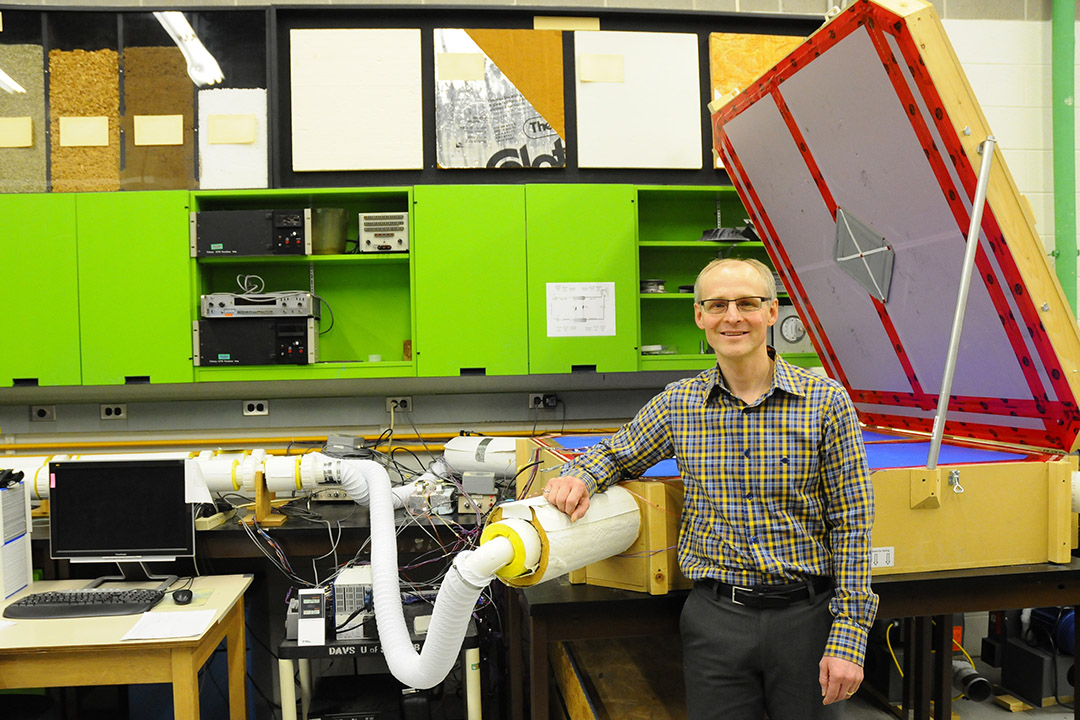
Engineering researchers take aim at airborne COVID-19 virus
NSERC has provided funding for several projects.
By USask Research Profile and ImpactDaily moments made potentially risky by COVID-19 such as cramming into a crowded bus or elevator, sitting in a packed classroom, and visiting a vulnerable relative in long-term care may be rendered safer again, thanks to new federally funded University of Saskatchewan (USask) research into ventilation systems.
Carey Simonson
With COVID-19 rapid-response funding from Canada’s Natural Sciences and Engineering Research Council (NSERC), USask engineering researcher Carey Simonson (PhD) is leading a team, along with industry partner Aldes Canada, to develop testing equipment to measure how airborne viruses are transferred in building ventilation systems.
"SARS-CoV-2 virus may remain airborne for hours and can be transported tens of metres indoors and even further within air ducts," said Simonson. "We want to see whether airborne viruses in the exhaust air of buildings are returned to the fresh supply air used to ventilate and reduce contaminants in buildings."
Simonson’s research will focus on developing air exchangers which conserve energy without contaminating fresh air, using a barrier membrane to prevent viruses and other tiny pathogens from penetrating. He expects to have preliminary results in six months, and if successful, effective membranes could be incorporated into air exchangers within a year.
Jafar Soltan
USask engineering researcher Jafar Soltan (PhD) is a co-investigator, with Simonson, on a new NSERC-funded project that aims to inactivate airborne pathogens using an air sanitization device. Soltan will test the effectiveness and feasibility of the device for use in the existing air conditioning systems.
"The research will improve indoor air quality, reducing the risk of spread of airborne pathogens in healthcare facilities, seniors’ residences and transit systems where maintaining adequate social distancing may be difficult,” said Soltan.
Soltan’s project, which also involves researchers from the USask College of Medicine, the USask Vaccine and Infectious Disease Organization—International Vaccine Centre (VIDO-InterVac), and industry partner Engineered Air, will assess whether virus particles can be made harmless using ozone gas activated by a catalyst.
Soltan expects to have results within one year.
Sven Achenbach
USask engineering researcher Sven Achenbach is investigating better drug development using the Canadian Light Source (CLS) synchrotron. Working with industry partner Applied NanoTools Inc. Achenbach will use the CLS, a national research facility of USask, to develop specialized “zone plates” that focus X-ray light. The plates can be used for the rapid design of new drugs to combat COVID-19 and other diseases.
Chris Zhang
USask mechanical engineering researcher Chris Zhang, working with USask PhD student Randy Lin and the Saskatchewan Health Authority, will look at how to combat COVID-19 through better data management. The team will study how various types of health information can be integrated to help healthcare decision makers, particularly health emergency managers, gather accurate information in a timely manner during a pandemic.
Additional USask projects
Other USask projects that have also received NSERC funding to fight COVID-19 include:
• Tracking possible introduction of COVID-19 virus into Canadian wildlife: Working with Environment and Climate Change Canada, Canadian Wildlife Health Cooperative, Harvard University, and USask’s VIDO-InterVac, a team of USask researchers led by veterinary microbiologist Vikram Misra and colleagues Darryl Falzarano and Emily Jenkins, along with biologist Christy Morrissey, will develop a blood test to monitor many wildlife species for exposure to SARS-CoV-2, the COVID-19-causing virus. It is very likely SARS-CoV-2 originated in a wild animal, and there’s a possibility the virus may jump back from people into wild animals, become stronger, and change itself for reintroduction into humans, Misra said.
Through the COVID rapid-response funding program, NSERC has awarded each of the USask projects nearly $50,000 for one year to address pandemic-related research and technical challenges, working with industry, public sector, and not-for-profit partners.

